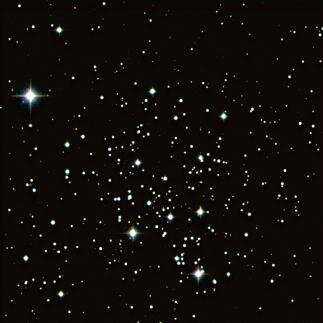May 15, 2019 report
Study finds open cluster NGC 2682 at least two times larger than previously thought

Based on new data from ESA's Gaia satellite, astronomers have provided more insights into properties of the nearby open cluster NGC 2682, revealing that its size is at least two times greater than previously believed. The findings are detailed in a paper published May 6 on the arXiv pre-print repository.
Located some 2,800 light years away, NGC 2682 (aka Messier 67, or M67 for short) is an open cluster in the constellation of Cancer. With an estimated age of about 3.6 billion years, it is one of the nearest old open clusters. Notably, its age and initial chemical composition is similar to that of the sun, hence astronomers even considered that the sun might actually have originated from NGC 2682.
Published about one year ago, the latest catalog of data from Gaia satellite (known as Data Release 2, or DR2) provides high-precision measurements, including positions in the sky, parallaxes and proper motions for more than 1 billion sources in the Milky Way. The release contains observational data collected by Gaia in the timespan of nearly two years – between July 25, 2014 and May 23, 2016.
DR2 has the potential of revealing more insights into the nature of NGC 2682 as astrometric information in this release could be a valuable tool to investigate extra-tidal regions of several open clusters in the solar neighborhood. So a team of European astronomers led by Ricardo Carrera of Astronomical Observatory of Padova in Italy recently decided to use DR2 in order to learn more about NGC 2682.
In particular, the researchers investigated the spatial distribution of this cluster of stars in order to constrain its dynamical evolution. Given that most open clusters should dissolve at an age of around 1 billion years, the fact that NGC 2682 survived until now suggests that it was likely much more massive in the past and has an interesting dynamical history.
"We use Gaia DR2 data to identify NGC 2682 members up to a distance of about 150 pc (10 degrees). Two methods (Clusterix and UPMASK) are applied to this end. We estimate distances to obtain three-dimensional stellar positions using a Bayesian approach to parallax inversion, with an appropriate prior for star clusters," the paper reads.
The main conclusion from the study conducted by Carrera's team is that NGC 2682 is at least twice as large than previously thought. Based on the DR2 data, the astronomers found that this cluster extends up to approximately 160 light years, while other observations carried out in the recent years suggested not more than 78 light years.
Furthermore, the study confirmed that NGC 2682 is mass-segregated with the most massive objects concentrated in the central regions. However, there are also stars outside the tidal radius of this cluster. The researchers assume that these extra-tidal stars in NGC 2682 may originate from external perturbations such as disk shocking or dynamical evaporation from two-body relaxation. They also plan more studies of the cluster to test these scenarios.
More information: R. Carrera, et al. The extended halo of NGC 2682 (M 67) from Gaia DR2. arXiv:1905.02020v1 [astro-ph.SR] arxiv.org/abs/1905.02020
© 2019 Science X Network




















